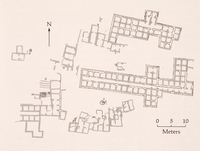| dc.description | Prehistoric site in the Jazira in northern Iraq, c. 100 km south-west of Mosul. Umm Dabaghiya was a specialized settlement and trading post that flourished c. 6200–c. 5750 bc and is an early ceramic site with distinctive architectural features. Many of the finest objects from the site are now to be found in the Iraq Museum, Baghdad. Diana Kirkbride conducted four seasons of excavation (1971–4), clearing a large area (c. 3000 sq. m). Periods of abandonment separated the four levels of occupation (IV–I). In the better-preserved earlier levels (IV–III) three blocks of double or triple rows of small, well-built, rectilinear compartments (each c. 1.5×2.0 m) defined three sides of a large open area. Their size and lack of household features indicate they were used for storage; the overall layout suggests a planned construction. Beyond these were small, irregular one- to three-roomed houses. Exterior ovens opened into the interior for hearths that had chimneys. Plastered steps and toeholds in the upper walls and the absence of doorways suggest that entry was from the roof. Some of the white-plastered interiors, especially in levels IV–III, had painted bands around the floor and naturalistic frescoes on the walls, one of which seems to depict an onager hunt (Baghdad, Iraq Mus.; see Mesopotamia, §VI, 1). The pottery is coarse and simple, with burnish, painting, incising, impressions or applied decoration, which in the later levels has parallels to early Hassuna culture (see Mesopotamia, §V, 1). Ground stone artefacts include limestone and alabaster bowls, ‘maceheads’, beads and small basalt axes. The chipped-stone tool assemblage and predominance of onager and gazelle remains over those of domesticated animals suggest a hunting rather than an agricultural or herding economy and the processing of hides and meat for trade. | en_US |


